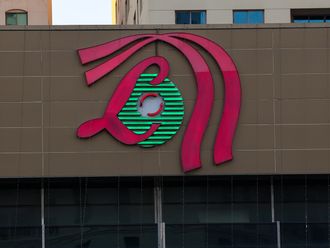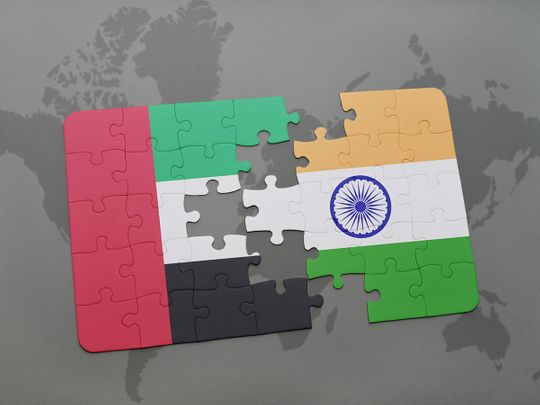
Abu Dhabi: The UAE and India have experienced remarkable growth in their bilateral relations in recent years, driven by deep-rooted ties, cultural exchanges, trade, and political engagement spanning decades.
The rapid expansion of economic and trade relations has paved the way for a multifaceted partnership between the two countries.
The UAE’s proactive approach to bolstering economic ties and forming trade alliances with key markets has played a significant role in this growth.
In line with this strategy, the country launched the Comprehensive Economic Partnership Agreements (CEPA) program in September 2021, including the CEPA with India, highlighting the swift progress in their relations.
Throughout 2022 and 2023, the bilateral ties between the UAE and India achieved significant milestones, further strengthening their mutual partnership.
During the past ten years (2013-2022), the trade growth rate between the two countries amounted to 18.2 per cent, from Dh159.72 billion to Dh188.8 billion last year, to reach Dh1.41 trillion in 10 years.
The UAE-India CEPA, which came into effect on May 1, 2022, was a great turning point in the two countries’ relations and benefitted Emirati businesses.
These include a reduction or waiving of tariffs on over 80 per cent of UAE goods exported to India, enabling Emirati businesses to trade more freely and fairly across the Indian border. Meanwhile, service providers now have enhanced market access across 11 vital sectors and over 100 sub-sectors.
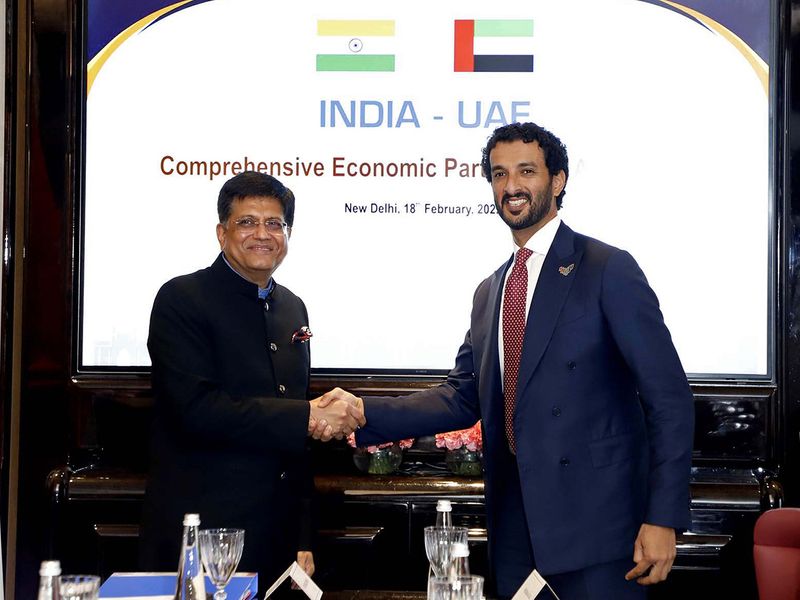
The agreement aims to facilitate trade between UAE and India by eliminating unnecessary technical barriers (TBT) for UAE and Indian exporters, using international standards as a basis for technical regulations. It also offers UAE businesses access to Indian government procurement opportunities, along with a 10 per cent price preference in UAE government procurement tenders.
Under the CEPA, the two countries established a Joint Committee to assess, revise and propose amendments to the CEPA, including improving market access.
In the period from May 2022 to April 2023, the first 12 months of the entry into force of the agreement, the value of bilateral non-oil trade amounted to $50.5 billion, a growth of 5.8 per cent over the same period last year, so the partnership achieved distinguished and positive economic results that enhanced the increase in the flow of trade exchange between the two countries.
Last year, the foreign trade between the two countries was represented in re-exports at a value of Dh48.4 billion, non-oil exports at Dh40.2 billion, and imports at Dh100.1 billion.
The 14th Session of the UAE-India Joint Committee Meeting, chaired by Sheikh Abdullah bin Zayed Al Nahyan, Minister of Foreign Affairs for the UAE, and Dr. Subrahmanyam Jaishankar, India’s Minister of External Affairs, marked another significant milestone.
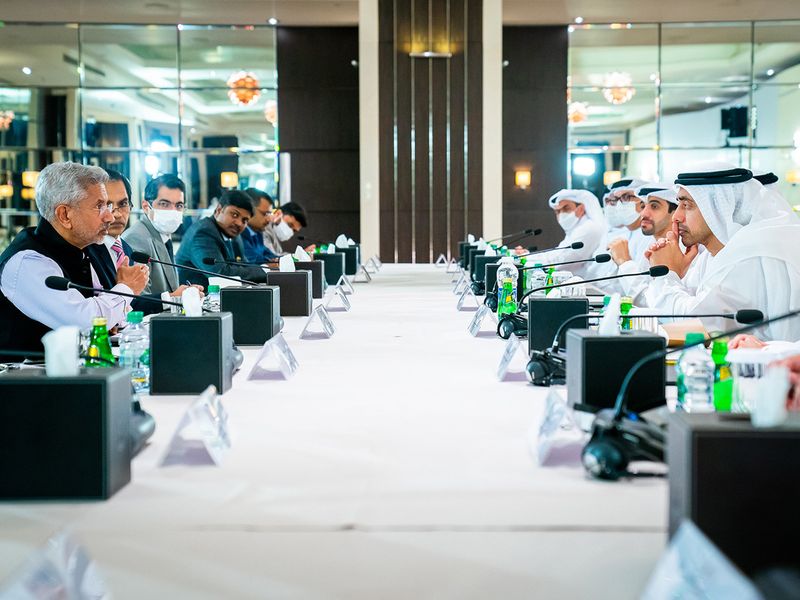
During the meeting, a Memorandum of Understanding (MoU) was signed between the Wildlife Institute of India and the International Fund for Houbara Conservation in the UAE. Additionally, an MoU was signed between the UAE’s Ministry of Foreign Affairs and the Ministry of External Affairs of India, establishing the UAE-India Cultural Council Forum.
In February, the UAE, France, and India announced a trilateral cooperation initiative, emphasizing their commitment to various fields such as energy and combating climate change. This trilateral initiative will promote cultural cooperation and contribute to sustainable projects, aligning with the Indian Presidency of the G20 and the UAE’s hosting of the 28th Conference of the Parties (COP28) in 2023.
The UAE and India also joined forces in combatting climate change by signing a Memorandum of Understanding (MoU) in May 2022. Their partnership aims to increase renewable energy, develop green hydrogen, establish carbon markets, improve agricultural efficiency, and support sustainable finance.
During his visit to India, Abdullah bin Touq Al Marri, Minister of Economy, held talks with various Indian ministers, officials and business leaders to explore ways to boost the two countries’ economic and trade relations.
The discussions focused on increasing and diversifying their mutual investments and explored new sectors, such as renewable energy, telecommunications, infrastructure, roads, real estate and startups.
The two countries also agreed to enhance and broaden their current economic ties, by launching new innovative projects that help businesses tap into the potential of their markets, and boost the development and outreach of startups in each country, by offering them more benefits and incentives to raise their GDP contributions.
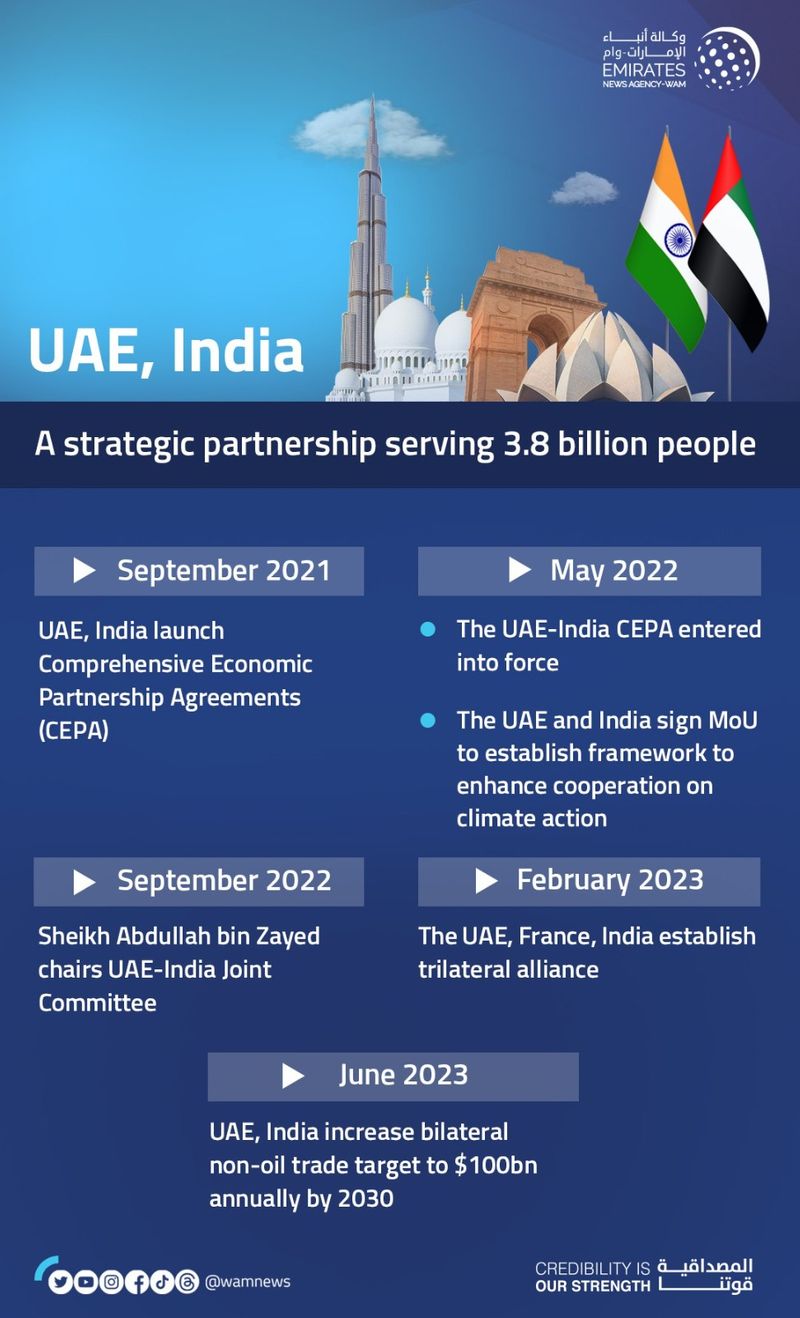
Several Emirati officials attended the annual conference of the Confederation of Indian Industry (CII) in New Delhi. At the conference, the global investment platform, Investopia, announced a new collaboration with the CII by signing an MoU, which aims to share expertise, organise trade missions, showcase knowledge resources, and highlight attractive investment opportunities in the Indian and Emirati markets in emerging economic sectors. Moreover, the two sides will organise joint events and conferences to foster communication between their business communities.
During the first CEPA Joint Committee meeting held last June, the UAE and India set a target of $100 billion in non-oil trade by 2030, according to Goyal.
Dr. Thani bin Ahmed Al Zeyoudi, Minister of State for Foreign Trade, said the CEPA had a positive effect on bilateral trade and investment, noting that the non-oil trade between the two countries reached $45.5 billion in the first 11 months after the agreement took effect on 1st May, 2022, a 6.9 per cent rise from the same period in the previous year.
June 2022 marked the first anniversary of the UAE-India CEPA signing. A high-level delegation, headed by Dr. Al Zeyoudi, attended the inaugural meeting of the CEPA joint committee.
The two sides agreed to operationalise the established committees, sub-committees, and technical council under the CEPA and launch a new sub-committee on Trade in Services. Additionally, it was agreed that the mutual exchange of preferential trade data would take place on a quarterly basis in order to ensure effective monitoring of the CEPA.




